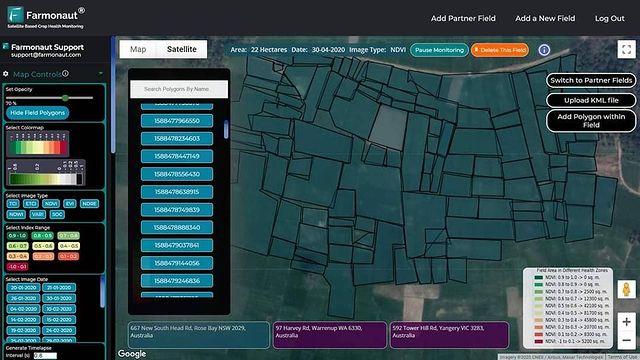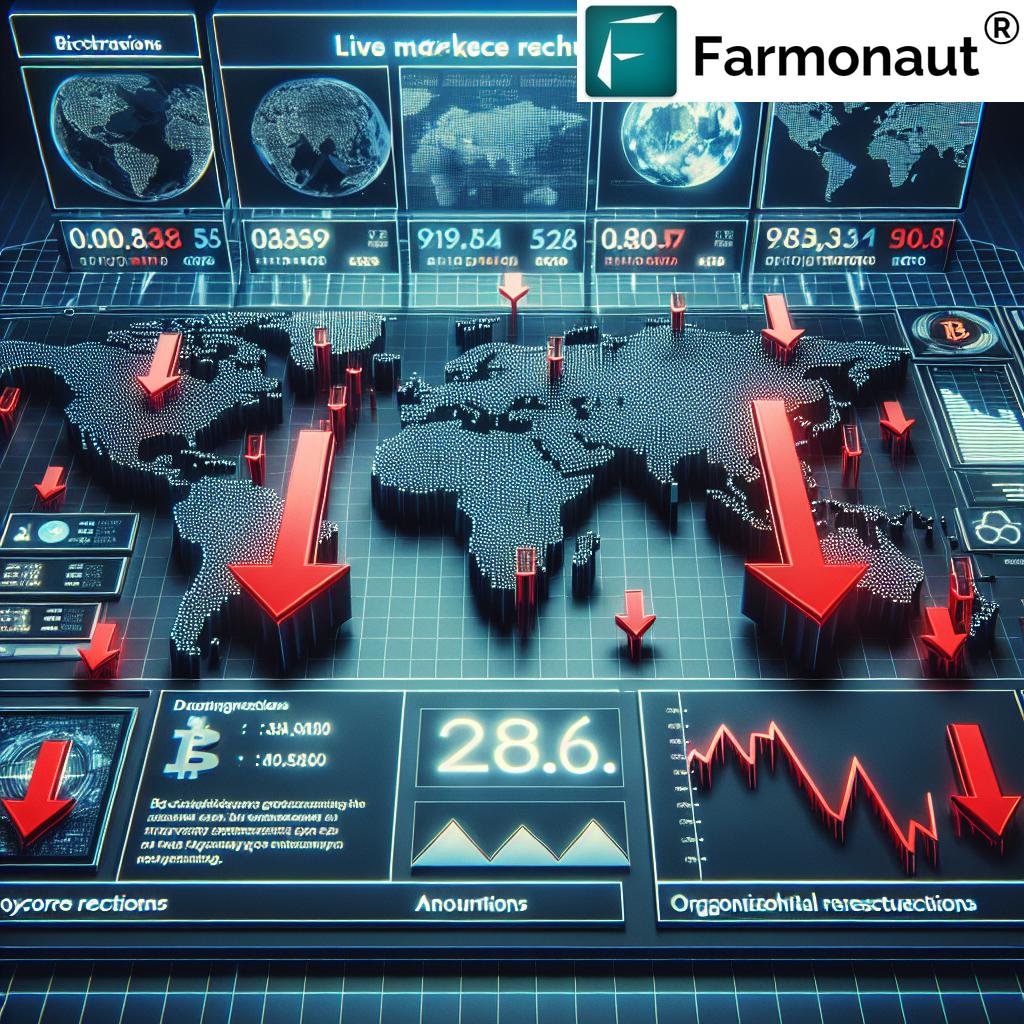Farmonaut Insight: Strategic Fertiliser Purchasing Amid Market Volatility – A Comprehensive Agricultural Sector Analysis
“Global fertilizer market volatility affects over 570 million farms worldwide, impacting food security for billions.”
In today’s rapidly evolving agricultural landscape, staying informed about fertiliser market trends and making strategic purchasing decisions has become crucial for farmers and agronomists alike. At Farmonaut, we understand the challenges faced by the agricultural sector, which is why we’ve compiled this comprehensive report on the current state of the fertiliser market, focusing on nitrogen, phosphate, and potash fertilisers.
As we delve into this analysis, we’ll explore how global supply chains, crop input demands, and geopolitical factors are shaping the fertiliser market. Our goal is to provide you with valuable agricultural sector insights that will help you navigate these turbulent times and make informed decisions for your farm or agribusiness.

Current State of the Fertiliser Market
The global fertiliser market has been experiencing significant volatility in recent years, driven by a complex interplay of factors. Let’s break down the current state of affairs for the three primary types of fertilisers:
- Nitrogen Fertilisers: As the most widely used type of fertiliser, nitrogen products have seen substantial price fluctuations. The production of nitrogen fertilisers is heavily dependent on natural gas, making them particularly susceptible to energy market fluctuations.
- Phosphate Fertilisers: Phosphate fertiliser supply has been affected by geopolitical tensions and trade restrictions in key producing countries. This has led to supply chain disruptions and increased price volatility.
- Potash Fertilisers: Potash price fluctuations have been driven by changes in global demand, particularly from major agricultural powerhouses like China and India. Recent geopolitical events have also impacted the potash market significantly.
To provide a clearer picture of the current market situation, we’ve compiled the following table:
| Fertiliser Type | Current Market Price ($/tonne) | Price Trend (last 6 months) | Supply Chain Status | Recommended Purchasing Strategy |
|---|---|---|---|---|
| Nitrogen (Urea) | 350-400 | Slightly Decreasing | Stable | Forward Purchase |
| Phosphate (DAP) | 500-550 | Increasing | Disrupted | Bulk Buy |
| Potash (MOP) | 450-500 | Volatile | Recovering | Wait and Monitor |
This table provides a snapshot of the current fertiliser market trends, offering insights into pricing, supply chain status, and recommended purchasing strategies for each major fertiliser type.
Factors Influencing Fertiliser Market Volatility
Understanding the drivers behind fertiliser market volatility is crucial for developing effective purchasing strategies. Let’s explore some of the key factors influencing the market:
- Energy Prices: The production of nitrogen fertilisers, in particular, is energy-intensive. Fluctuations in natural gas prices directly impact fertiliser production costs and, consequently, market prices.
- Geopolitical Tensions: Trade disputes, sanctions, and political instability in key producing regions can disrupt supply chains and cause sudden price spikes.
- Climate Change: Extreme weather events can affect both fertiliser production and agricultural demand, leading to market unpredictability.
- Global Food Demand: As the world population grows and dietary habits change, the demand for agricultural products increases, driving up fertiliser demand.
- Currency Exchange Rates: Since fertilisers are traded globally, currency fluctuations can impact prices for importers and exporters.
At Farmonaut, we closely monitor these factors to provide our users with up-to-date agricultural market reports and insights. Our satellite-based crop monitoring technology helps farmers optimize their fertiliser use, reducing costs and improving efficiency in the face of market volatility.
Explore our crop monitoring solutions: 
Strategic Fertiliser Purchasing: Mitigating Price Volatility Risks
In light of the current market conditions, it’s essential for farmers and agribusinesses to adopt strategic approaches to fertiliser purchasing. Here are some tactics to consider:
- Forward Purchasing: Locking in prices for future delivery can protect against potential price increases. This strategy works well when prices are relatively low or expected to rise.
- Bulk Buying: Purchasing larger quantities during periods of lower prices can provide cost savings and ensure supply availability. However, this requires adequate storage facilities and careful financial planning.
- Diversification of Suppliers: Relying on multiple suppliers can help mitigate risks associated with supply chain disruptions or regional price fluctuations.
- Use of Financial Instruments: Futures contracts and options can be used to hedge against price volatility, though this requires a good understanding of financial markets.
- Precision Agriculture Techniques: Implementing precision farming methods, such as those offered by Farmonaut, can optimize fertiliser use and reduce overall costs.
“Nitrogen fertilizers account for approximately 60% of global fertilizer use, playing a crucial role in crop yields.”
By leveraging Farmonaut’s satellite-based crop health monitoring and AI-driven advisory systems, farmers can make more informed decisions about fertiliser application, potentially reducing overall usage and costs while maintaining or even improving yields.
Soil Health and Fertiliser Efficiency: A Sustainable Approach
While managing fertiliser costs is crucial, it’s equally important to consider the long-term health of your soil and the efficiency of your fertiliser use. Here are some key points to consider:
- Soil Testing: Regular soil testing helps determine the exact nutrient needs of your crops, preventing over-application of fertilisers.
- Crop Rotation: Implementing a diverse crop rotation can help maintain soil health and reduce the need for synthetic fertilisers.
- Cover Crops: Planting cover crops can improve soil structure, prevent erosion, and add organic matter to the soil, potentially reducing fertiliser requirements.
- Precision Application: Using precision agriculture techniques, such as variable rate technology, can ensure that fertilisers are applied only where and when they’re needed most.
- Organic Matter Management: Incorporating organic matter into the soil can improve its structure and nutrient-holding capacity, enhancing fertiliser efficiency.
At Farmonaut, our satellite-based crop monitoring technology can help you track soil health indicators and optimize your fertiliser application strategies. By combining this data with our AI-powered advisory system, you can make more informed decisions about soil management and fertiliser use.
Discover our AI-powered advisory system: 

Crop Input Demand Analysis: Tailoring Strategies to Market Needs
Understanding crop input demand is crucial for both farmers and fertiliser producers. Let’s examine the current trends and projections for major crop categories:
- Cereals: Global demand for cereals remains strong, driven by population growth and changing dietary habits. This sustained demand is likely to keep fertiliser requirements high for these crops.
- Oilseeds: The growing biofuel industry and increasing demand for plant-based proteins are driving up oilseed production, consequently increasing fertiliser demand in this sector.
- Fruits and Vegetables: As health consciousness rises globally, the demand for fruits and vegetables is increasing. This trend is likely to sustain fertiliser demand in horticulture.
- Cotton: The textile industry’s recovery post-pandemic is expected to boost cotton production, potentially increasing fertiliser demand in cotton-growing regions.
By analyzing these trends, we can better understand how crop input demands might affect fertiliser markets in the coming seasons. Farmonaut’s crop area estimation technology can provide valuable insights into planting trends, helping both farmers and industry stakeholders make more informed decisions.

Agricultural Sector Insights: Market Fluctuations and Production Strategies
The agricultural sector is constantly evolving, influenced by various factors including market fluctuations, technological advancements, and changing consumer preferences. Here are some key insights into current trends and production strategies:
- Precision Agriculture Adoption: The use of precision agriculture techniques, including satellite-based monitoring and variable rate applications, is on the rise. These technologies help farmers optimize input use, including fertilisers, leading to cost savings and improved yields.
- Sustainable Farming Practices: There’s a growing emphasis on sustainable farming methods, driven by consumer demand and environmental concerns. This trend is influencing fertiliser use strategies, with a focus on more efficient and environmentally friendly applications.
- Diversification: Many farmers are diversifying their crops to spread risk and tap into new market opportunities. This strategy can also help in managing soil health and reducing reliance on specific fertilisers.
- Technology Integration: The integration of technologies like IoT sensors, drones, and AI-powered analytics is transforming farm management. These tools provide real-time data on crop health and soil conditions, enabling more precise fertiliser application.
- Market-Oriented Production: Farmers are increasingly aligning their production with market demands, which can influence fertiliser use patterns. Understanding market trends is crucial for making informed decisions about crop selection and input investments.
At Farmonaut, we’re committed to supporting farmers in navigating these trends. Our satellite-based crop monitoring and AI advisory systems provide valuable insights that can help in adapting to market fluctuations and optimizing production strategies.
Explore our API for custom integration: Farmonaut API | API Developer Docs
Optimizing Farm Operational Costs in a Volatile Market
In the face of fertiliser market volatility, optimizing farm operational costs becomes crucial for maintaining profitability. Here are some strategies to consider:
- Implement Precision Agriculture: Utilize technologies like Farmonaut’s satellite-based crop monitoring to optimize fertiliser application, reducing waste and improving efficiency.
- Invest in Soil Health: Focus on improving soil organic matter and microbial activity to enhance nutrient availability and reduce fertiliser dependency.
- Explore Alternative Nutrient Sources: Consider organic fertilisers, green manures, or crop residues as complementary nutrient sources to reduce reliance on synthetic fertilisers.
- Optimize Irrigation: Efficient irrigation practices can improve fertiliser uptake and reduce losses, leading to cost savings.
- Conduct Regular Financial Analysis: Keep track of input costs, yield data, and market prices to make informed decisions about crop selection and fertiliser investments.
By implementing these strategies and leveraging Farmonaut’s advanced agricultural technologies, farmers can better navigate market volatility while maintaining productive and sustainable operations.
Looking Ahead: Future Trends in the Fertiliser Market
As we look to the future, several trends are likely to shape the fertiliser market and impact agricultural practices:
- Shift Towards Sustainable Fertilisers: Increasing environmental concerns may drive the development and adoption of more sustainable fertiliser options, including bio-fertilisers and slow-release formulations.
- Technological Advancements: Continued innovations in precision agriculture, including AI and satellite technology, will enable more efficient fertiliser use and application methods.
- Circular Economy Approaches: There may be a greater focus on recovering and recycling nutrients from waste streams, potentially reducing reliance on synthetic fertilisers.
- Climate Change Adaptation: As climate patterns shift, fertiliser strategies may need to adapt to changing growing conditions and crop requirements.
- Policy Influences: Government policies aimed at reducing environmental impacts may shape fertiliser markets and usage patterns in the coming years.
At Farmonaut, we’re committed to staying at the forefront of these trends, continually evolving our technology to provide farmers with the most up-to-date and effective tools for managing their operations in an ever-changing agricultural landscape.
Conclusion: Empowering Informed Decision-Making in Agriculture
Navigating the complexities of the fertiliser market requires a combination of strategic planning, market awareness, and technological adaptation. By staying informed about fertiliser market trends, implementing sustainable farming practices, and leveraging advanced technologies like those offered by Farmonaut, farmers and agribusinesses can better position themselves to thrive in an ever-changing agricultural landscape.
Remember, the key to success lies in making informed decisions based on accurate, real-time data. Farmonaut’s suite of tools, including our satellite-based crop monitoring, AI-powered advisory system, and blockchain-based traceability solutions, are designed to provide you with the insights you need to optimize your operations and navigate market volatility effectively.
As we move forward, the agricultural sector will continue to face challenges, but with the right strategies and tools, these challenges can be transformed into opportunities for growth and innovation. Stay connected with Farmonaut for the latest agricultural market reports and insights, and let us help you cultivate success in your farming endeavors.
Frequently Asked Questions (FAQ)
- How often should I check fertiliser market prices?
We recommend monitoring prices at least weekly, with more frequent checks during periods of high volatility or when planning major purchases. - What factors should I consider when deciding between different types of fertilisers?
Consider your soil type, crop requirements, local climate, price, and environmental impact. Soil testing can help determine specific nutrient needs. - How can Farmonaut’s technology help me optimize my fertiliser use?
Our satellite-based crop monitoring and AI advisory system provide real-time insights into crop health and soil conditions, enabling more precise and efficient fertiliser application. - Are there any government subsidies or programs available to help with fertiliser costs?
This varies by country and region. Check with your local agricultural department or extension office for information on available programs. - How can I improve my soil health to reduce fertiliser dependency?
Implement practices like crop rotation, cover cropping, and incorporating organic matter. Regular soil testing and precision agriculture techniques can also help optimize nutrient management.












